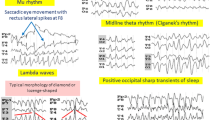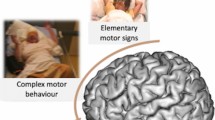Abstract
We have described the occurrence in freely moving gerbils of slow potential changes (SPC) in two different models of experimental epilepsy: 1) maximal electroshock and 2) bilateral epileptic foci induced by penicillin.SPC is considered a by-product of epileptiform activity in both models and correlates to the SPC which occurs during spreading depression. In the first model there develops a cortical SPC simultaneous with a depression of EEC activity, although there is no propagation of the wave. We suggest that a non-propagated multifocal depression (MD) occurs in the MES model. In the model of focal epilepsy, all requirements are fulfilled, and the SPC is characterized as the one which occurs during spreading depression propagating with an average velocity of 8 mm/min.
Similar content being viewed by others
References
Browne, T.R., Tonic-clonic (grand mal) seizures. In: Browne, T.R., Feldman, R.G., eds.Epilepsy, Diagnosis and Management, Little, Brown and Co., Boston, 1983,pp. 51–60.
Bures, J. and Buresova, O. (1960). The use of Leao's spreading cortical depression in research on conditioned reflex.EEG Clin. Neurophysiol. (suppl). 13: 359–376.
Caspers, H. and Speckman, E.J. (1969). DC potential shifts in paroxysmal states. In Jasper, H.H., Ward, A.A. and Pope, A. (eds.),Basic Mechanisms of Epilepsy, Little, Brown and Co., Boston, pp. 375–388.
de Azeredo, F.A.M., Guedes, R.C.A. and Perret, M.L. (1986). Methodology for recording slow potential changes in unanesthetized gerbils.Braz. J. Med Biol. Res. 19: 477A.
de Azeredo, F.A.M., Bonfim, C.H., Heringer, C. and Fuzimoto, J. (1990). An electrode to record slow potential changes in different structures of the brain in awake animals during convulsion and spreading depression.Soc. Neurosci (suppl.) 16: 1337.
do Carmo, R.J. and Martins Ferreira, H. (1984). Spreading depression of Leao probed with ion selective microelectrodes in isolated chick retina.An. Acad. Bras. Ci. 56:401–422.
Johnson, W.L., Goldring, S. and O'Leary, J.L. (1965). Behavioral, unit and slow potential changes in methionine sulfoximine seizures.EEG Clin. Neurophysiol. 18: 229–238.
Krivanek, J. (1958). Changes in brain glycogen in the spreading EEG depression of Leao.J. Neurochem. 2: 337–343.
Krivanek, J. (1961). Some metabolic changes accompanying Leao's spreading cortical depression in the rat.J. Neurochem. 6: 183–189.
Krivanek, J. (1944). Adenosine 3′–5′ monophosphate in the rat cerebral cortex: effect of potassium ionsin vivo (cortical spreading depression).J. Neurochem. 26: 359–390.
Leao, A.A.P. and Morison, R.S. (1963). Propagation of spreading depression. In: Brazier, M.A.B.(ed.),Brain function, cortical excitability and study potentials, Univ. California Press, Berkeley, pp 78–85.
Lust, W.D. and Passonneau, J.V. (1976). Cyclic nucleotides in murine brain: effect of hypothermia on adenosine monophosphate, glycogen phosphorylase, glycogen synthase and metabolites following maximal electroshock or decapitation.J. Neurochem. 26: 11–16.
Luca, A.M., Pivik, R.T. and Chorover, S.L. (1977). Electroconvulsive shock: effect on sleep and cortical steady potential in the rat.Physiol. Beh. 18: 997–1003.
Marques, H.J.A. and de Azeredo, F.A.M. (1982). Spreading depression during convulsions in unanesthetized gerbils.An. Acad. Bras. Ci. 54: 261.
Marques, H.J.A., Lust, W.D. and de Azeredo, F.A.M. (1983). Biochemical and electrophysical correlation during maximal electroshock in gerbils.II∘Simposio Brasileiro de Nuerquimica (abstr.) 38.
Marshall, W.H. (1959) Spreading cortical depression of Leao.Physiol. Rev. 39: 239–279.
Nicholson, C. (1984). Comparative neurophysiology of spreading depression in the cerebellum.An. Acad. Bras. Ci. 56: 481–494.
Ochs, S., Hunt, K. and Booker, H. (1961). Spreading depression using chronically implanted electrodes.Am. J. Physiol. 200: 1211–1214.
Oitzl, M.S. and Huston, J.P. (1984). Electroencephalographic spreading depression and concomitant behavioral changes induced by intrahippocampal injection of ACTH (1–24) and D-Ala 2-Met-enkephalinimide in the rat.Brain. Res. 308: 33–42.
Rebert, C.S., Pryor, G.T. and Schaeffer, J.A. (1974). Slow potential consequences of electroconvulsive shock in the rats.Physiol. Beh. 12: 131–134.
Sprick, V., Oitzl, M.S., Ornstein, K. and Huston, J.P. (1981). Spreading depression induced by microinjection of enkephalins into the hippocampus and neocortex.Brain Res. 210: 243–252.
Van Harrevald, A. (1953). Spreading cortical convulsions and depressions.J. Neurophysiol. 26: 352–366.
Van Harreveld, A. and Stamm, J.S. (1954). Consequences of cortical convulsive activity in rabbit.J.Neurophysiol. 27: 505–520.
Author information
Authors and Affiliations
Rights and permissions
About this article
Cite this article
de Azeredo, F.A.M., Perret, M.L. Cortical slow potential changes during convulsions induced by maximal electroshock or penicillin focus. Metabolic Brain Disease 7, 101–113 (1992). https://doi.org/10.1007/BF01000149
Received:
Accepted:
Issue Date:
DOI: https://doi.org/10.1007/BF01000149




